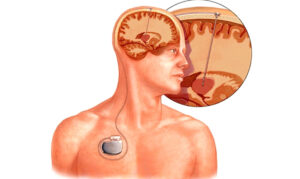Brain Battery, Parkinson's Treatment
It is a fact that our Parkinson’s or other movement disorder patients with severe motor disorders have difficulty even doing their own work.
Thanks to Brain Battery Surgery, we cannot eliminate the disease, but we correct the motor findings of the disease.

Neurosurgery Surgery / Deep Brain Stimulation
Deep brain stimulation (DBS) involves placing electrodes in specific areas of the brain. It provides treatment when these electrodes create electrical currents that regulate abnormal stimuli, or when electrical stimuli affect certain cells and chemicals in the brain.
In deep brain stimulation, the amount of stimulation is controlled by a pacemaker-like device placed under the skin in the upper chest. A wire running under your skin connects this device to the electrodes in your brain.
 What Is Deep Brain Stimulation Used For?
What Is Deep Brain Stimulation Used For?
Deep brain stimulation, also known as Brain Battery, is a treatment method that is frequently used in the treatment of essential tremor, movement disorders such as Parkinson’s disease and dystonia, and psychiatric conditions such as obsessive-compulsive disorder. It can also be used to reduce seizures in treatment-resistant epilepsy. This treatment is recommended for people whose symptoms cannot be controlled with medications.
How to Prepare for Deep Brain Stimulation?
Even if your disease and condition are suitable for deep brain stimulation, you and your doctors should discuss the risks and potential benefits of the procedure. Before surgery, you will likely need medical tests to be sure that deep brain stimulation is the right and safe option for you. You may also need brain imaging studies. These studies help to map the areas of your brain where the electrodes will be implanted.
In general, deep brain stimulation surgery procedures are as follows:
- Brain Surgery: For the neurosurgery department, your care team wears a special headgear (stereotactic headgear) to keep your head still during the procedure. Team members then use neuroimaging (brain magnetic resonance imaging or brain tomography) to map your brain and identify the area in the brain where they will place the electrodes.
In most cases, the electrodes will be placed while you are awake and alert. This is to ensure that the effects of the stimulation can be fully tested. If you are awake for surgery, you will be given a local anesthetic to numb your scalp before the procedure, but you will not need anesthesia in your own brain as the brain does not have pain receptors. In some cases, surgery may be performed under general anesthesia to make you unconscious.
Your surgeon places a thin wire tip with several contact points (electrodes) on the ends into a specific area of your brain. Or one electrode is implanted on both sides of the brain (for a total of two electrodes). A wire passes under your skin to a pulse generator (neurostimulator) implanted near your collarbone.
During surgery, both the neurologist and surgeon carefully monitor your brain to help ensure correct electrode placement.
- Chest Wall Surgery: In the second part of the surgery, the surgeon places the part of the device containing the batteries (pulse generator) under the skin on your chest, near your collarbone.
General anesthesia is used during this procedure. Wires from brain electrodes are placed under your skin and routed to a battery-operated pulse generator.
The generator is programmed to send continuous electrical pulses to your brain. You can control the generator and turn it on and off using a special remote control.
A few weeks after surgery, the pulse generator in your chest is activated in your doctor’s office. The doctor can easily program your pulse generator from outside your body using a special remote control. The amount of stimulation is customized to your situation and it can take up to four to six months to find the most suitable setting.
Stimulation may be constant 24 hours a day, or depending on your situation, your doctor may suggest that you turn off your pulse generator at night and turn it back on in the morning. You can turn the stimulation on and off with a special remote control you take home with you. In some cases, your doctor may program the pulse generator to allow you to make minor adjustments at home.
Your generator’s battery life will vary depending on usage and settings. If the battery needs to be replaced, your surgeon will replace the generator during the outpatient procedure.
Results of Neurosurgery Surgery
Brain Battery surgery will not cure your disease, but it may help reduce your symptoms. If deep brain stimulation works, your symptoms will improve significantly, but they usually do not go away completely. In some cases, medications may be needed for certain conditions.
Deep brain stimulation is not successful for everyone. There are a number of variables involved in the success of deep brain stimulation. Before surgery, it’s important to talk to your doctor about what kind of improvement you can expect for your condition.

 What Is Deep Brain Stimulation Used For?
What Is Deep Brain Stimulation Used For?